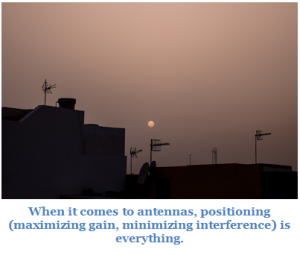Building 3G Signal: Setting up Point to Point and Point to Multi-point Configurations


A good antenna configuration maximizes the gain of a cellular repeater system (whether a 3G signal booster antenna or another variation). This resource is a quick guide to the two types of antennas(point to point connection or point to multi-point), the two types of antenna configuration, and to measuring the gain of antenna(s) during installation.
Let’s start with the basics. Every antenna configuration consists of one or more of these two types of antennas:
– A directional antenna, like the popular Yagi-Uda antenna, transmits data in one direction only. Because its signal is concentrated in that direction, further than an omnidirectional antenna. Cell tower arrays usually consist of multiple directional antennas. A directional antenna can transmit data further than an omnidirectional antenna. Cell tower arrays usually consist of multiple directional antennas.

– An omnidirectional antenna transmits data uniformly in all directions on one plane. An omnidirectional antenna has a shorter range than a directional antenna, but is useful because it synthesizes signals from multiple points.

In a point to point configuration two directional antennas (positioned on the same imaginary line) exchange signals. Installing a directional antenna facing the nearest cell tower establishes a point to point connection between that tower and your home.
Multiple point to point connections with the different cell towers around your home increase signal strength. To avoid interference, never install directional antennas pointing at each other. Point to point connections should not overlap.
Point to point configurations are most efficient, particularly in areas where cell towers are sparse. Concentrating the energy output in the direction of the nearest tower(s) means energy is not wasted transmitting in a direction where there is no tower.
In a point to multi-point> configuration one omnidirectional antenna (the master) exchanges signals with multiple directional antennas (the slaves). Installing a master omnidirectional antenna establishes a point to multi-point connection with every slave (cell tower) that falls within your antenna’s range.
You should not install multiple omnidirectional antennas on your property. This will only increase interference. To improve signal strength in a point to multi-point configuration, install an omnidirectional antenna with a high power output.

Cell phone bars are not the most accurate measurement of signal strength, so switch your phone to field test mode to test the effectiveness of your antenna(s) during installation.
– To access field test mode on iOS phones, dial the code *3001#12345#* into the keypad and press call.
-To access field test mode on Android phones, go to “Settings” > “About Phone” > “Network” or “Status”.
Signals are measured in a negative number of decibels (dB), where a closer proximity to zero indicates a better signal. A signal of -0.25dB, for example, is better than a signal of -0.50dB.
– On iOS phones in field test mode, the signal strength reading is available in the top left-hand corner.
– On Android phones, the signal strength is listed under either “Network” or “Status”.
If your phone has an RF port (newer phones, including the iPhone and Samsung Galaxy, do not), you can plug it into the antenna directly. This will give you the most accurate signal strength readings while you adjust the antenna(s). If your phone does not have an RF port, place it close to the antenna while you adjust it.





